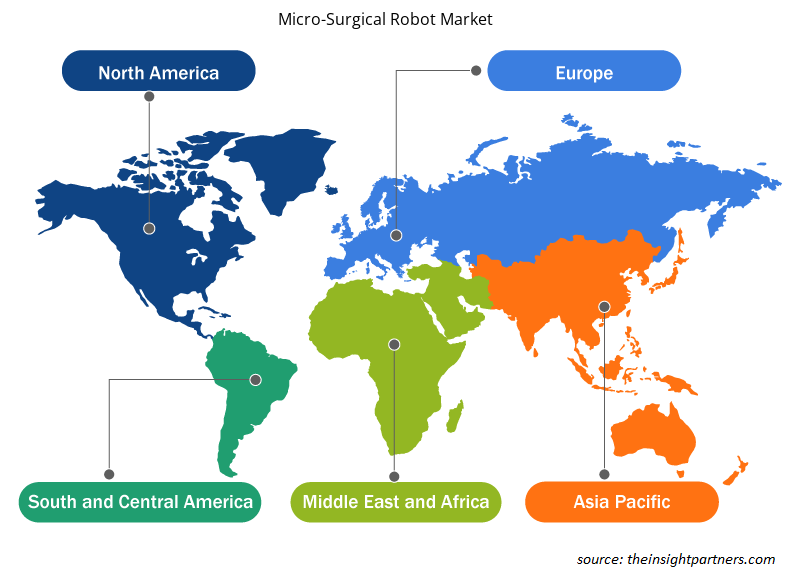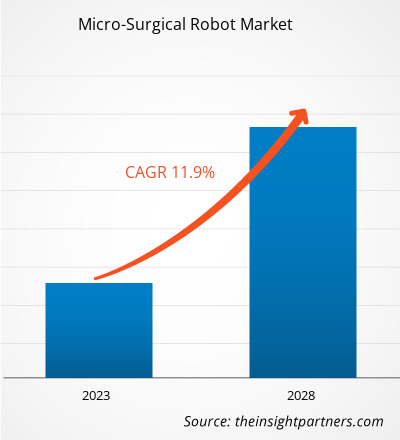من المتوقع أن ينمو سوق الروبوتات الجراحية الدقيقة من 1،280.81 مليون دولار أمريكي في عام 2022 إلى 2،817.57 مليون دولار أمريكي بحلول عام 2028؛ ومن المتوقع أن ينمو بمعدل نمو سنوي مركب قدره 11.9٪ من عام 2022 إلى عام 2028.
تُستخدم الروبوتات الجراحية الدقيقة لإجراء الجراحات الدقيقة ، أي الإجراءات الجراحية داخل الجسم وخارجه . يمكن للروبوتات المساعدة في إجراء العمليات الجراحية المعقدة بشكل أكثر مرونة ودقة، وهو أمر ممكن بالتقنيات التقليدية. تُجري الروبوتات الجراحية الدقيقة إجراءات جراحية طفيفة التوغل بشقوق صغيرة. تتمثل مزايا الروبوتات الجراحية الدقيقة في حدوث مضاعفات أقل، وندوب صغيرة، وفقدان أقل للدم، وتعافي أسرع. إن الشعبية المتزايدة للإجراءات الجراحية طفيفة التوغل، ومزايا الجراحات الروبوتية من حيث الدقة، والتكرار، والتحكم، والكفاءة تغذي نمو سوق الروبوتات الجراحية الدقيقة العالمية . ومع ذلك، فإن التكلفة العالية للروبوتات الجراحية الدقيقة وسيناريوهات السداد غير المواتية في بلدان مختلفة تعيق نمو السوق.
يقدم التقرير رؤى وتحليلات متعمقة لسوق الروبوتات الجراحية الدقيقة العالمية، مع التركيز على معايير مثل اتجاهات السوق والتقدم التكنولوجي وديناميكيات السوق وتحليل المشهد التنافسي الذي يركز على كبار اللاعبين في السوق. كما يتضمن تأثير جائحة كوفيد-19 على السوق في جميع المناطق. أوصت العديد من السلطات الصحية بتجنب الاتصال البشري بسبب تزايد انتقال العدوى والضغط على موارد الرعاية الصحية من خلال تأجيل الجراحات الاختيارية وتعليق العيادات الخارجية وفرز الموظفين المشاركين في الرعاية العاجلة. تستخدم الجراحات الروبوتية الذكاء الاصطناعي، الذي يستفيد من ثلاثة جوانب: زيادة الدقة وتقليل مخاطر الفشل من خلال توفير استقلالية مشتركة وكاملة في المهام البسيطة؛ السماح بالتباعد الجسدي عن طريق تغيير دور الجراح من تنفيذي إلى إشرافي ومن أفراد التحكم المستمر إلى أفراد التحكم المتقطع؛ وزيادة متوسط عدد العمليات الجراحية، والتي ستكون مطلوبة لمعالجة الجراحات المتراكمة الناجمة عن إغلاق الجراحات الاختيارية لفترة طويلة. وبالتالي، شهد سوق الروبوتات الجراحية الدقيقة العالمية تأثيرًا إيجابيًا بعد الموجة الأولى من كوفيد-19.
قم بتخصيص هذا التقرير ليناسب متطلباتك
ستحصل على تخصيص لأي تقرير - مجانًا - بما في ذلك أجزاء من هذا التقرير، أو تحليل على مستوى الدولة، وحزمة بيانات Excel، بالإضافة إلى الاستفادة من العروض والخصومات الرائعة للشركات الناشئة والجامعات
- احصل على أهم اتجاهات السوق الرئيسية لهذا التقرير.ستتضمن هذه العينة المجانية تحليلاً للبيانات، بدءًا من اتجاهات السوق وحتى التقديرات والتوقعات.
يتم تقسيم سوق الروبوتات الجراحية الدقيقة العالمية على أساس المكون والتطبيق والمستخدم النهائي والجغرافيا. من حيث الجغرافيا، يتم تقسيم السوق على نطاق واسع إلى أمريكا الشمالية وأوروبا ومنطقة آسيا والمحيط الهادئ والشرق الأوسط وأفريقيا وأمريكا الجنوبية والوسطى.
نظرة عامة على السوق
ومزايا الجراحات الروبوتية من حيث الدقة والقدرة على التكرار والتحكم والكفاءة
إن إدخال الجراحة الروبوتية هو أحدث التطورات في شفط الدهون. يتحكم الجراح في العلاجات من وحدة تحكم رئيسية، بينما تقوم عربة المريض الروبوتية بإجراء العمليات بشكل أسهل وأكثر دقة من أنظمة المنظار. نظرًا لرؤيتها ثلاثية الأبعاد ودقتها، وأدواتها متعددة النطاقات البديهية، تتمتع الجراحة الروبوتية بمزايا واضحة في إجراءات شفط الدهون مقارنة بالجراحات التنظيرية التقليدية، مما يضمن سلامة أكبر للمريض. تساعد الجراحات الروبوتية أيضًا في تحسين قدرات الخياطة، وتقليل الألم بعد الجراحة ووقت التعافي. يوصى أيضًا بشفط الدهون بمساعدة الروبوت للأفراد البدينين الذين يزيد وزنهم عن 250 كجم، حيث أن شفط الدهون بالمنظار أكثر صعوبة وتطلبًا. وفقًا لمقال - "مقارنة النتائج الجراحية بين الجراحة الروبوتية المتكاملة والجراحة التنظيرية التقليدية لاستئصال المعدة البعيدة : تحليل مطابقة درجة الميل"، نُشر في عام 2020، كان معدل النجاح الجراحي في مجموعة استئصال المعدة البعيدة الروبوتية المتكاملة ( IRDG ) 98٪، وهو أعلى بكثير من معدل النجاح في مجموعة استئصال المعدة البعيدة بالمنظار التقليدي ( CLDG )، أي 89.5٪. على الرغم من أن كلتا المجموعتين كانت لديهما معدلات مماثلة من مشاكل المرضى الداخليين والخارجيين، إلا أن معدل إعادة القبول في مجموعة IRDG كان أقل بكثير من مجموعة CLDG . علاوة على ذلك، تساعد الجراحات الروبوتية في تحسين قدرات التصور، مما يوفر للجراحين رؤية أفضل لمنطقة العمل ويسمح لهم برؤية التفاصيل المجهرية باستخدام كاميرات عالية الدقة. تتمتع هذه الأنظمة بمهارة أكبر من اليد البشرية، وقدرتها على الدوران 360 درجة والتنقل بشكل أفضل تسمح للجراحين بالوصول إلى المناطق التي يصعب الوصول إليها. قام فريق من الباحثين بدمج ذراع تعمل بالنيتروجين (كذراع روبوتية خامسة) مع نظام عدسة فيديو تكبير بصري (ذراع Point-Setter وعدسة VITOM من Karl Storz ، Tuttlingen ، ألمانيا) لتطوير منصة روبوتية لعلاجات الجراحة المجهرية الروبوتية خارج الجسم . VITOM هو نظام فيديو خارجي عالي الدقة مع عدسات بصرية تستخدم في جراحة العمود الفقري وجراحة الأطفال. يتراوح التكبير البصري في النظام من 16 × إلى 25 ×. يمكن لجراح المجهر عرض الصورة من نظام VITOM أسفل عرض كاميرا الروبوت الرئيسية ثلاثية الأبعاد باستخدام برنامج التصوير TilePro في واجهة الجراح. وبالتالي، فإن الجراحات المجهرية الروبوتية ضمان قدر أكبر من الدقة والقدرة على التكرار والتحكم والكفاءة. وتماشياً مع الرغبة المتزايدة في الحصول على خدمات رعاية صحية أفضل وأسرع، فإن فوائد الروبوتات الجراحية الدقيقة تدفع نمو السوق.
رؤى قائمة على المكونات
بناءً على المكون، ينقسم سوق الروبوتات الجراحية الدقيقة العالمية إلى أدوات وملحقات. في عام 2022، من المتوقع أن يحظى قطاع الأدوات بحصة سوقية أكبر. ومن المتوقع أن ينمو سوق هذا القطاع بمعدل نمو سنوي مركب أسرع خلال فترة التنبؤ.
رؤى قائمة على التطبيق
بناءً على التطبيق، يتم تقسيم سوق الروبوتات الجراحية الدقيقة إلى جراحة إعادة البناء التجميلية، وجراحة الأنف والأذن والحنجرة، وجراحة المسالك البولية ، وجراحة الأعصاب ، وجراحة العيون، وجراحة الجهاز اللمفاوي، وغيرها. في عام 2022، من المتوقع أن يشكل قطاع جراحة المسالك البولية الحصة الأكبر من السوق. ومن المتوقع أن يسجل نفس القطاع أعلى معدل نمو سنوي مركب من عام 2022 إلى عام 2028.
رؤى تعتمد على المستخدم النهائي
بناءً على المستخدم النهائي، يتم تقسيم سوق الروبوتات الجراحية الدقيقة إلى المستشفيات والعيادات ومراكز الجراحة الخارجية ومعاهد الأبحاث وغيرها. في عام 2022، من المتوقع أن يستحوذ قطاع المستشفيات والعيادات على أكبر حصة من السوق. ومن المتوقع أن يسجل نفس القطاع أعلى معدل نمو سنوي مركب من عام 2022 إلى عام 2028. ويعزى نمو سوق الروبوتات الجراحية الدقيقة لقطاع المستشفيات والعيادات إلى ارتفاع عدد العمليات الجراحية واعتماد المعدات المتقدمة في هذه المرافق.
يتبنى اللاعبون في سوق الروبوتات الجراحية الدقيقة استراتيجيات عضوية مثل إطلاق المنتجات والتوسع لتوسيع نطاق وجودهم العالمي ومحفظة منتجاتهم وتلبية الطلب المتزايد. على سبيل المثال، في مايو 2022، أعلنت شركة MMI SpA عن إطلاق محاكي نظام الجراحة Symani، الذي طورته شركة VirtaMed.
رؤى مبنية على الجغرافيا
من حيث الجغرافيا، يتم تقسيم سوق الروبوتات الجراحية الدقيقة العالمية إلى أمريكا الشمالية وأوروبا وآسيا والمحيط الهادئ (APAC) والشرق الأوسط وأفريقيا (MEA) وأمريكا الجنوبية والوسطى. يتم تقسيم السوق في أمريكا الشمالية إلى الولايات المتحدة وكندا والمكسيك. يتم تقسيم سوق الروبوتات الجراحية الدقيقة في أوروبا إلى فرنسا وألمانيا والمملكة المتحدة وإسبانيا وإيطاليا وبقية أوروبا. يتم تقسيم سوق الروبوتات الجراحية الدقيقة في منطقة آسيا والمحيط الهادئ إلى الصين والهند واليابان وأستراليا وكوريا الجنوبية وبقية منطقة آسيا والمحيط الهادئ. يتم تقسيم السوق في منطقة الشرق الأوسط وأفريقيا إلى المملكة العربية السعودية والإمارات العربية المتحدة وجنوب أفريقيا وبقية منطقة الشرق الأوسط وأفريقيا. يتم تقسيم سوق الروبوتات الجراحية الدقيقة في أمريكا الجنوبية والوسطى إلى البرازيل والأرجنتين وبقية منطقة أمريكا الجنوبية
رؤى إقليمية حول سوق الروبوتات الجراحية الدقيقة
لقد قام المحللون في Insight Partners بشرح الاتجاهات والعوامل الإقليمية المؤثرة على سوق الروبوتات الجراحية الدقيقة طوال فترة التوقعات بشكل شامل. يناقش هذا القسم أيضًا قطاعات سوق الروبوتات الجراحية الدقيقة والجغرافيا في جميع أنحاء أمريكا الشمالية وأوروبا ومنطقة آسيا والمحيط الهادئ والشرق الأوسط وأفريقيا وأمريكا الجنوبية والوسطى.

- احصل على البيانات الإقليمية المحددة لسوق الروبوتات الجراحية الدقيقة
نطاق تقرير سوق الروبوتات الجراحية الدقيقة
| سمة التقرير | تفاصيل |
|---|---|
| حجم السوق في عام 2022 | 1.28 مليار دولار أمريكي |
| حجم السوق بحلول عام 2028 | 2.82 مليار دولار أمريكي |
| معدل النمو السنوي المركب العالمي (2022 - 2028) | 11.9% |
| البيانات التاريخية | 2020-2021 |
| فترة التنبؤ | 2023-2028 |
| القطاعات المغطاة | حسب المكون
|
| المناطق والدول المغطاة | أمريكا الشمالية
|
| قادة السوق وملفات تعريف الشركات الرئيسية |
|
كثافة اللاعبين في سوق الروبوتات الجراحية الدقيقة: فهم تأثيرها على ديناميكيات الأعمال
يشهد سوق الروبوتات الجراحية الدقيقة نموًا سريعًا، مدفوعًا بالطلب المتزايد من المستخدم النهائي بسبب عوامل مثل تفضيلات المستهلكين المتطورة والتقدم التكنولوجي والوعي الأكبر بفوائد المنتج. ومع ارتفاع الطلب، تعمل الشركات على توسيع عروضها والابتكار لتلبية احتياجات المستهلكين والاستفادة من الاتجاهات الناشئة، مما يؤدي إلى زيادة نمو السوق.
تشير كثافة اللاعبين في السوق إلى توزيع الشركات أو المؤسسات العاملة في سوق أو صناعة معينة. وهي تشير إلى عدد المنافسين (اللاعبين في السوق) الموجودين في مساحة سوق معينة نسبة إلى حجمها أو قيمتها السوقية الإجمالية.
الشركات الرئيسية العاملة في سوق الروبوتات الجراحية الدقيقة هي:
- ام ام اي سبا
- مايكروشور بي في
- شركة سترايكر
- شركة الجراحة البديهية
- ميدترونيك
إخلاء المسؤولية : الشركات المذكورة أعلاه ليست مرتبة بأي ترتيب معين.

- احصل على نظرة عامة على أهم اللاعبين الرئيسيين في سوق الروبوتات الجراحية الدقيقة
الشركات الكبرى
تعد كل من MMI SpA؛ وMicrosure BV؛ وStryker Corporation؛ وIntuitive Surgical, Inc.؛ وMedtronic؛ وGalen Robotics, Inc.؛ وEthicon (Johnson & Johnson Services, Inc.)؛ وAsensus Surgical, Inc.؛ وZimmer Biomet؛ وTitan Medical Inc.؛ وForSight Robotics LTD من بين الشركات الرائدة العاملة في سوق الروبوتات الجراحية الدقيقة العالمية.
- التحليل التاريخي (سنتان)، سنة الأساس، التوقعات (7 سنوات) مع معدل النمو السنوي المركب
- تحليل PEST و SWOT
- حجم السوق والقيمة / الحجم - عالمي، إقليمي، بلد
- الصناعة والمنافسة
- مجموعة بيانات إكسل
التقارير الحديثة
تقارير ذات صلة
شهادات العملاء
سبب الشراء
- اتخاذ قرارات مدروسة
- فهم ديناميكيات السوق
- تحليل المنافسة
- رؤى العملاء
- توقعات السوق
- تخفيف المخاطر
- التخطيط الاستراتيجي
- مبررات الاستثمار
- تحديد الأسواق الناشئة
- تحسين استراتيجيات التسويق
- تعزيز الكفاءة التشغيلية
- مواكبة التوجهات التنظيمية





















 احصل على عينة مجانية ل - سوق الروبوتات الجراحية الدقيقة
احصل على عينة مجانية ل - سوق الروبوتات الجراحية الدقيقة